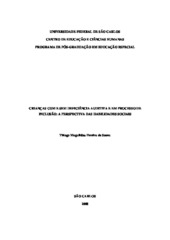| dc.contributor.author | Souza, Thiago Magalhães Pereira de | |
| dc.date.accessioned | 2016-06-02T19:46:12Z | |
| dc.date.available | 2010-05-19 | |
| dc.date.available | 2016-06-02T19:46:12Z | |
| dc.date.issued | 2008-03-07 | |
| dc.identifier.citation | SOUZA, Thiago Magalhães Pereira de. Children with and without hearing impairment and inclusion process: the social skills perspective. 2008. 113 f. Dissertação (Mestrado em Ciências Humanas) - Universidade Federal de São Carlos, São Carlos, 2008. | por |
| dc.identifier.uri | https://repositorio.ufscar.br/handle/ufscar/3058 | |
| dc.description.abstract | Children with hearing impairments which study into the regular school can be isolated andrejected by their peer group and can exhibit more learning disability, emotional andbehavior problems than children that don't have deficiencies. Theoretical field of socialskills has been dedicated to the study of these questions. However the literature don tindicate which performances from the children could contribute or hinder the inclusion ofchildren with hearing impairments on their interpersonal relations, just as there a few dataon the relations between these performances and the social isolation and rejection by thepeer group, academic competence and behavior problems. This work was divided into tworesearches. The purpose of the research I consists in identify the inclusive social skills,by categorizing the pro-included performances and from the anti-included performances.Participated in this research I eight children with hearing impairments and 128 childrenwithout deficiency of eight classes of 1ª the 4ª grades of regular schools. By means offilming from the classes in the classroom and classes of the physical education, have beenidentified and categorized 30 pro-included performances and 20 anti-includedperformances from the children. The objective of the research II was observe the relationamong the pro-included performances and the anti-included performances and: a) the socialskills; b) the behavior problems; c) the academic competence; d) the sociometric statusfrom the children. Participated in this research II eight children with hearing impairmentsand eight children without deficiency of eight classes of 1ª the 4ª grades of regular schools.The statistically descriptive analysis suggested the relation among these performances andthe repertory of social skills and the academic competence from the children. The datarelative to the behavior problems and the sociometric status from the children don t suggestthe relation among these variables and the pro-inclusive performances and anti-inclusiveperformances. | eng |
| dc.description.sponsorship | Universidade Federal de Minas Gerais | |
| dc.format | application/pdf | por |
| dc.language | por | por |
| dc.publisher | Universidade Federal de São Carlos | por |
| dc.rights | Acesso Aberto | por |
| dc.subject | Educação especial - inclusão | por |
| dc.subject | Deficiência auditiva | por |
| dc.subject | Relações humanas | por |
| dc.subject | Habilidades sociais | por |
| dc.subject | Desempenhos pró-inclusivos | por |
| dc.subject | Desempenhos anti-inclusivos | por |
| dc.subject | Inclusion | eng |
| dc.subject | Hearing impairments | eng |
| dc.subject | Pro-included performances | eng |
| dc.subject | Anti-included performances | eng |
| dc.subject | Social skills | eng |
| dc.title | Crianças com e sem deficiência auditiva e em processo de inclusão: a perspectiva das habilidades sociais | por |
| dc.title.alternative | Children with and without hearing impairment and inclusion process: the social skills perspective | eng |
| dc.type | Dissertação | por |
| dc.contributor.advisor1 | Del Prette, Almir | |
| dc.contributor.advisor1Lattes | http://lattes.cnpq.br/2191226494887247 | por |
| dc.description.resumo | Crianças com deficiência auditiva que estudam no ensino regular podem ser isoladas erejeitadas pelo grupo de pares e podem apresentar mais dificuldades de aprendizagem,comportamentos problemáticos e problemas emocionais do que as crianças que nãoapresentam deficiência. O campo teórico das habilidades sociais tem se dedicado ao estudodestas questões. Porém, a literatura não tem apontado quais os desempenhos das criançasque poderiam contribuir e/ou dificultar a inclusão da criança com deficiência auditiva nassuas relações interpessoais, assim como há poucos dados sobre as relações entre estesdesempenhos e o isolamento social e rejeição pelo grupo de pares, competência acadêmicae ocorrência de comportamentos problemáticos. Este trabalho foi dividido em dois estudos.O Estudo I teve como objetivo identificar classes de habilidades sociais inclusivas, pormeio da categorização dos desempenhos pró-inclusivos e dos desempenhos anti-inclusivos.Participaram do Estudo I, oito crianças com deficiência auditiva e 128 crianças semdeficiência de oito classes de 1ª a 4ª séries de escolas regulares. Por meio de filmagens dasaulas em sala e de aulas de educação física, foram identificados e categorizados 30desempenhos pró-inclusivos e 20 desempenhos anti-inclusivos das crianças com e semdeficiência auditiva. O Estudo II teve o objetivo de observar a relação entre desempenhospró-inclusivos e desempenhos anti-inclusivos e: a) as habilidades sociais; b) a ocorrência decomportamentos problemáticos; c) a competência acadêmica; d) o status sociométrico dascrianças com e sem deficiência auditiva. Participaram do Estudo II, oito crianças comdeficiência auditiva e oito crianças sem deficiência de oito classes de 1ª a 4ª séries deescolas regulares. A análise estatística descritiva sugeriu a relação entre estes desempenhose o repertório de habilidades sociais e a competência acadêmica das crianças. Os dadosrelativos à ocorrência de comportamentos problemáticos e ao status sociométrico dascrianças não sugeriram a relação entre estas variáveis e a freqüência dos desempenhos próinclusivose anti-inclusivos. | por |
| dc.publisher.country | BR | por |
| dc.publisher.initials | UFSCar | por |
| dc.publisher.program | Programa de Pós-Graduação em Educação Especial - PPGEEs | por |
| dc.subject.cnpq | CIENCIAS HUMANAS::EDUCACAO::TOPICOS ESPECIFICOS DE EDUCACAO::EDUCACAO ESPECIAL | por |
| dc.contributor.authorlattes | http://lattes.cnpq.br/5873272860746197 | por |
